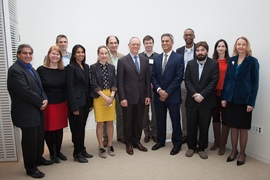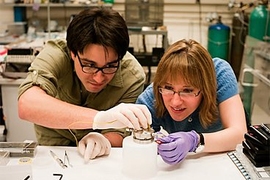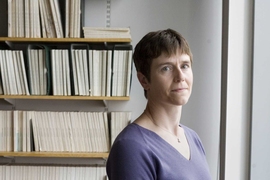Since 2013, the Professor Amar G. Bose Research Grant has been supporting MIT faculty with big, bold, and unconventional research visions. In the latest round of grants, four proposals from six MIT faculty members — Angela Belcher, Betar Gallant, Amy Keating, Karl Berggren, Domitilla Del Vecchio, and Ron Weiss — were awarded from more than 100 project submissions. The researchers aim to make groundbreaking advances in areas of environmental bioremediation, cell reprogramming, new electrochemical reactions, and protein nanofabrication.
The researchers were honored at a Nov. 21 reception featuring past and current awardees, hosted by MIT President L. Rafael Reif.
Bose Grants are awarded to support innovative projects that may be unlikely to receive funding through traditional means but will offer fellows an exciting opportunity for exploration likely to benefit their fields of research. Grants provide up to $500,000 over three years for each selected project.
The grant program celebrates the legacy of the late Amar Bose, a longtime member of the MIT faculty and the founder of Bose Corporation, well known for his visionary and intellectually adventurous career. “My father would be very happy with the innovation and freedom of exploration that these grants have made possible as it was exactly what he was all about,” said his son Vanu Bose ’88, SM ’94, PhD ’99, at the reception. “The awards acknowledge the spirit of insatiable curiosity that my father embraced.”
“Through the Bose Research Grant program, which is now in its fourth year, we have a unique community of individuals synonymous with learning, teaching, exploration, and opportunity,” said President Reif. “MIT is about making a better world, and I cannot think of a better example of this than what the Bose research fellows and scholars are doing at MIT today.”
Toxin-eating yeast
“Our plan is to develop environmentally friendly, on-demand biological systems for cleaning up the environment,” says Angela Belcher, who is the James Mason Crafts Professor in biological engineering and materials science and engineering, and a member of the Koch Institute for Integrative Cancer Research. Her idea proposes using the humble yeast cell to act as a multifunctional, even programmable, bioremediation agent to clean up heavy metals and other environmental contaminants.
Belcher plans to design new yeast strains with genes from other organisms that have a natural inclination to ingest heavy metals and other toxins. By altering the yeast genes, Belcher can selectively program what genes to turn on and off. Much like commercially available yeast products, Belcher’s multifunctional yeast would be manufactured, packaged, stored, and shipped to environmentally affected areas as needed. “Our goal is to provide on-demand yeast products that can be used to clean up waste sites — from sources such as mining, manufacturing, agricultural runoff, and chemical disasters — that are easily used, recovered, and disposed of safely,” she adds.
Belcher has a successful history in redirecting natural biological processes for new purposes. Her team has repurposed natural biological agents to develop solar cells and battery technology. “It’s about natural evolution, which we are very good at, and getting biology to work with a new toolkit,” she says. “This grant allows us to take our expertise into a different direction, which is remediation.”
Reprogramming a cell’s fate
Using today’s technologies, researchers can reprogram cells of the body into stem cells capable of becoming any cell type. However, massive amounts of biochemical factors are required to force the change. And even when this reprogramming happens, less than 1 percent of the original cells actually make the full transformation to a stem cell. For more than 10 years, these issues have plagued practical applications of these induced stem cells in medicine.
Domitilla Del Vecchio, associate professor in the Department of Mechanical Engineering, and Ron Weiss, a professor in the departments of Biological Engineering and Electrical Engineering and Computer Science, propose a new technology that may offer the promise of substantially increased transformation efficiency, with smaller amounts of factors required. “Our project is about changing how the reprogramming process works,” says Del Vecchio. The pair proposes a feedback strategy whereby the cell itself adds in the needed factors at different times along the process transformative process. “We want to make a genetic circuit that can be inserted into the cell so that the cell automatically adjusts the level of needed factors,” she explains.
Adds Weiss, “Our approach is to push the cells to make the protein factors needed to both induce the change while also overriding the cells’ natural resistance which essentially fights the change.”
Harnessing the power of controlled explosions
Betar M. Gallant, the Esther and Harold E. Edgerton Career Development Assistant Professor in the Department of Mechanical Engineering, wants to build better energy systems. Her grant-winning proposal looks to create new dissolved-gas electrochemical reactions to provide substantially higher cell voltages and energy compared with current technology. A key feature of this project will be to learn to control high-potential, complex, multistep reactions.
“I want to develop tools that open up new reaction chemistries,” says Gallant. “The word ‘explosion’ conjures visions of poorly controlled and violent processes, yet electrochemistry provides us a unique handle to manipulate reactions by tuning all aspects of the reaction microenvironment. If we can learn how to design a stable and robust cell around a target reaction, we can harness that energy as electrical work.”
She is looking at designs involving a variety of gases whose theoretical reactions involve multiple electrons at high potentials. “This could be a great springboard to look at reactions that are starting to be conceived to push the limits of electrochemistry,” she says, adding that dissolved-gas reaction are largely unexplored. Looking ahead, she believes this approach could open up new pathways and new concepts in the design of chemistries, reactors, and processes for both stationary and portable power delivery.
Tool Kit for Novel Protein Nanofabrication
“We are looking for ways to combine two different fields — protein engineering and nanofabrication — to build a tool kit for arranging biomolecules in new ways on physical interfaces,” says Amy Keating, a professor of biology, explaining her project work with Karl Berggren, a professor of electrical engineering.
Keating, whose work centers on how proteins interact and function, will partner with Berggren, a nanofabrication and electrical engineering scientist, to explore new technologies for combining proteins with advanced silicon device surfaces. “We are hoping to find new ways of building very small-scale biological molecule complexes on surfaces,” she says. While living organisms naturally organize proteins and DNA into intricate pathways and complexes for a variety of functions, few engineering solutions are available now to provide that kind of design complexity.
Berggren and Keating hope to create giant biomolecular systems with the complexity of integrated circuits by leveraging their expertise in designing custom proteins with nanofabrication techniques. “We are looking at ways of making scaffolds that we can attach more complex molecules to, like sensors, or for driving biological interactions,” says Berggren. Though they are not themselves focused on a particular application, the researchers imagine possible uses for this work in the life sciences, materials sciences, and in computing.















